CLINICAL HIGHLIGHTS
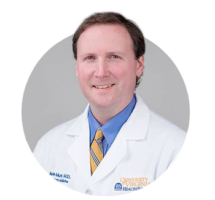 By Justin Mutter, MD
By Justin Mutter, MD
VIRGINIA AT HOME: UVA’s NEW HOME-BASED PRIMARY CARE PROGRAM FOR HIGH-RISK OLDER ADULTS
There are millions of homebound older adults across the United States. Often referred to as the “invisible” homebound—because our clinic- and hospital-centric health care systems struggle to meet their medical needs until major concerns result in hospitalization—this population tends to have complex medical and psychosocial needs. The gap between homebound persons’ needs and our ability to meet those needs results in poor health outcomes and high care costs. What’s more, the homebound population is growing exponentially in numbers. A recent study in JAMA Internal Medicine found that the population of homebound older adults nearly tripled over approximately the last year.
To close this gap in central Virginia, the Section of Geriatrics, in collaboration with the Memory and Aging Care Clinic in the Department of Neurology and the UVA Center for Health Humanities and Ethics, launched Virginia at Home (VaH), UVA’s first home-based primary care (HBPC) program for high-risk homebound older adults. The program serves not only the Charlottesville metropolitan area but also its surrounding rural counties. Significant inequities in access to HBPC exist across geographic, racial, and socioeconomic lines, and VaH is committed to reducing these inequities. In addition to its clinical mission, VaH is an interprofessional practice that aims to be a medium for interprofessional education at UVA, taking medical, nursing, and pharmacy students and trainees on house calls across the year.
Now into its second year, VaH has served over 75 participants and their caregivers. Within the VaH cohort in its inaugural year, the program reduced hospitalizations by approximately 80% and emergency department visits by approximately 50%. VaH’s interprofessional team includes Karen Duffy (nurse practitioner), Tuula Ranta (nurse coordinator), Bethany Delk (clinical pharmacist), and Justin Mutter (medical director). This year, VaH’s team is eager to continue growing the program in service to our community. Interested in referring a patient for consideration? Eligible participants must be homebound according to Medicare criteria. Referrals can be placed through the “ambulatory referral to geriatrics” order option in Epic.
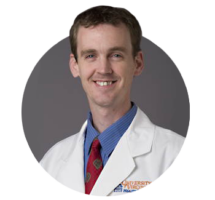 By Josh Barclay, MD
By Josh Barclay, MD
INPATIENT HOSPICE
The Palliative Care Team, Mortality Coalition, and Inpatient Hospice Oversight Group continue with the hospice transition experience. Our goal remains to improve end-of-life care across all clinical settings, which includes enhancing discharges with community hospice services (home hospice, SNF hospice, the CAHC unit) as well as inpatient conversions.
The UVA inpatient hospice care option, begun in November 2019, is intended to offer hospice services for patients too ill to leave the facility who also meet general inpatient care hospice criteria. We have now transitioned over 220 patients to inpatient hospice care and are improving patient discharges to hospice in the community. This accomplishment is a testament to the effort of more than one hundred people over the past two years in positions both clinical and administrative.
For patients who qualify for hospice general inpatient care, inpatient transition to hospice services is available seven days per week during daytime hours. We are continually working to streamline the process but find that successful changes are most easily accomplished when:
1. Hospice is considered as an option early in the end-of-life discussion.
2. The Palliative Care Consultation Service is involved early to ensure that patients meet general inpatient criteria for inpatient hospice. This is important because not all patients at the end of life are candidates for inpatient hospice care.
3. The process is started as early in the day as possible. Beginning transitions after 1-2 PM may be precluded by staffing availability.
Our Palliative Care physicians, nurse practitioners, and nurse palliative care consultants are an essential resource to help care for your patients with end-of-life challenges.
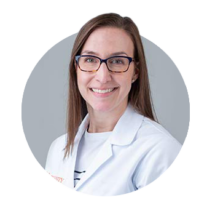 By Brittany Cavanaugh, DO
By Brittany Cavanaugh, DO
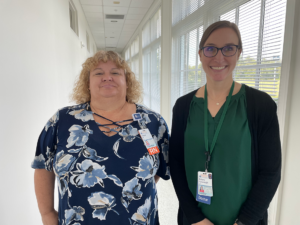
Chanel Hammer, RN and Brittany Cavanaugh, DO
CHRONIC HEPATITIS C INFECTIONS
In the Summer of 2020, Brittany Cavanaugh, DO, with the help of Chanel Hammer, RN, began treating Chronic Hepatitis C infections at University Physicians, Orange (UPO). Of the nine referrals from colleagues in Orange, seven have successfully completed treatment and received cure confirmation, and two are awaiting treatment completion. Additionally, they are monitoring the Hepatitis C screening rates at UPO and have noted an increase in the screening of 70% of the eligible population. Hepatitis C referral base expansion is expected in the near future.
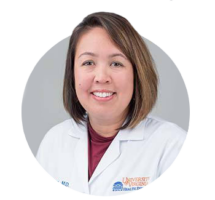 By Lien Dame, MD
By Lien Dame, MD
UPO’S TRANSITIONAL CARE MANAGEMENT (TCM) PROGRAM
Thanks to Chanel Hammer, RN, and Meador Horne, RN, UPO’s Transitional Care Management program succeeded in preventing hospital readmissions. The program includes: a call by a RN with 48 hours of discharge from the hospital for medication reconciliation and a visit with the PCP within 14 days.
% of patients readmitted to UVA within 30-days of hospitalization:
2019- 22%
2020- 12.22%
2021- 9.89%
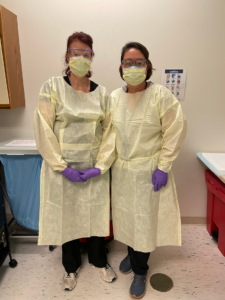
Deb Adams, PA, and Lien Dame, MD preparing to collect COVID-19 samples in clinic
UNIVERSITY PHYSICIANS ORANGE’S RESPIRATORY CLINIC
During the early days of the pandemic, University Physicians of Orange quickly realized that their patients did not have access to readily available COVID-19 testing. Being in a rural area frequently means limited resources and for patients with transportation difficulties, getting to Charlottesville for testing was not an option. In October 2020, Orange quickly pivoted some of its resources to develop its respiratory clinic. They aimed to test patients with respiratory symptoms such as cough, fever, and shortness of breath and provide COVID and flu testing if appropriate.
Initially, there were challenges, such as limited PPE, swabs for testing, waiting room space, and staff. However, Orange created a separate sick waiting room and exam rooms to distort ill patients from well patients. Their clinicians and nursing staff did an excellent job learning how to safely don/doff their PPE, handle COVID nasopharyngeal samples, and maintain a safe environment for patients and staff. Orange coordinated with Phlebotomy and Radiology to provide these services to sick patients. Erin Pearsall (Practice Supervisor) is credited with the many schedule adjustments that allowed ill patients to get same-day appointments quickly.
To date, Orange has evaluated and treated approximately 730 patients in their respiratory clinic. It has been an excellent service to their patients during the pandemic, who appreciate being seen by clinicians they know and trust in their primary care clinic.
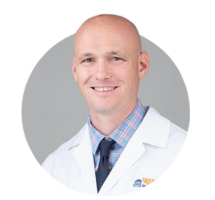 By David Callender, MD
By David Callender, MD
BEHAVIORAL HEALTH INTEGRATION AT UMA
Behavioral Health (BH) is a key factor that leads to poorer health outcomes, higher utilization of acute care services and has been identified as one of the top priorities for our community through the MAPP2Health process. We have committed to integrating BH into primary care as a strategy to address this issue and improve patient outcomes. Before the start of the BH integration Pilot Program at UMA, 33.3% of UMA patients had a behavioral health diagnosis; however, only 10.6% of UMA patients received any Behavioral Health services through UVA Health. Patients referred to community-based behavioral health providers outside of UVA were often returning to the clinic, stating that they could not get established with services due to lack of providers, lengthy waiting lists to be seen, and high thresholds that needed to be met to schedule appointments. To address the behavioral health needs of our UMA patients, we expanded services in the primary care sector to include provision of psychotherapy, diagnostic clarification, and medication recommendations from a multidisciplinary team that includes PCPs, an LCSW, a part-time psychologist, and a part-time consulting psychiatrist.
What we are doing
Patients present to the clinic with behavioral health needs are screened for anxiety and depression using standardized screening tools, PHQ9 and GAD7. Those patients receiving average scores or higher and desiring psychotherapy and/or those who require diagnostic clarification and medication recommendations are referred through EPIC to our behavioral health team at UMA. Referrals are reviewed, and patients are scheduled for psychotherapy and/or diagnostic assessments that will occur at UMA Clinic, often getting an initial appointment within two weeks. When PCPs request medication recommendations, the UMA psychiatry consultant reviews records and/or meets with the patient to suggest a medication course to PCP, who will then manage. Additionally, the behavioral health providers in clinic are also used to provide immediate or consultative care for patients while they are participating in their UMA appointments, including in-office crisis intervention, suicide, and homicide screenings. Patients with urgent needs may be seen during their clinic visit instead of directed elsewhere for care.
Expected process outcomes include increasing numbers of patients screened for depression and anxiety during primary care appointments, increasing psychotherapeutic sessions occurring within the clinic, and increasing collaborative interactions between primary care and psychiatry. Expected health outcomes include decreasing the number of ED visits and hospitalizations for screened patients, improvements from baseline PHQ9 and GAD7 scores (pre-post), and increasing PCP knowledge of and comfort with the provision of behavioral health treatment.
Outcomes & Future State
UMA completed the first year of the Behavioral Health Pilot Program in June 2021 and is already seeing benefits to our patient population. Four hundred thirty-two patients were referred to the program in year one. Overall the GAD7/PHQ9 Scores for those patients in the Behavioral Health Pilot Program have improved an average of about 2 points compared to their baseline screenings, with more significant changes seen in specific populations (women, people of color, Spanish-speakers). We have had a considerable increase in the amount of PHQ9 & GAD7 screenings conducted by our patients. We more than doubled the number of expected encounters, with 224 patients receiving 873 behavioral health encounters for psychotherapy, diagnostic clarification, and medication recommendations.
We are now continuing this program into the second year and anticipate further benefits as we hypothesize that value will be added in continued reduction of depression and anxiety scores, prevention of ED visits, reduction in psychiatric hospitalizations and length of stay for served patients, and improvement in equity of service provision in a particularly acute patient population.
RESEARCH HIGHLIGHTS
 By Tabor Flickinger, MD
By Tabor Flickinger, MD
POSITIVELINKS
Tabor Flickinger in General Medicine has been working with a multidisciplinary team on mobile health projects. PositiveLinks is a clinic-centered engagement in care program that includes a tailored smartphone app to help support patients living with chronic conditions. The program is supported by the Virginia Department of Health and led by Dr. Dillingham in the Division of Infectious Disease and Dr. Ingersoll in Psychiatry and Neurobehavioral Sciences. PositiveLinks has been associated with improved engagement in care and viral suppression for people living with HIV. An adaptation called HOPE has been piloted to support people receiving medication-assisted treatment for opioid use disorder.
Dr. Flickinger has been focused on the qualitative and mixed methods analyses of app usage for communication and connection to care. Participants can interact anonymously with their peers to enhance social support and use secure messaging to communicate with their care team. These tools have been essential during the COVID-19 pandemic when access to social support and medical care can be disrupted, and mobile health provides opportunities to bridge those gaps with virtual connections.
The following steps include adapting and evaluating PositiveLinks in a multi-site efficacy trial, supported by NIMH, with ongoing formative work. In addition, Dr. Flickinger is fostering collaborations across Grounds with colleagues in the Schools of Nursing and Engineering to explore Natural Language Processing techniques to analyze patient-clinician communication.
EDUCATIONAL HIGHLIGHTS
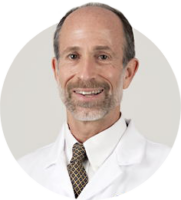 By Andy Wolf, MD
By Andy Wolf, MD
RESIDENCY EDUCATION
The Division faculty continue to lead the way in residency education, starting, of course, with Dr. Brian Uthlaut, who has provided inspirational leadership through the Covid-19 pandemic, not just with resident rotations and education, but also successfully pivoting the residency recruitment process from live to virtual. In addition, five of the residency’s Associate Program Directors are also Divisional faculty (Rachel Kon, Allison Lyons, Alex Millard, Andrew Parsons, and Andy Wolf).
The “+1” week ambulatory curriculum for the residency, overseen by Drs. Kon and Wolf feature many members of the Division. The curriculum includes a new Tuesday morning primary care lecture series, interactive Office-Based Medicine case-based sessions, an array of workshops and seminars addressing all of the ACGME competencies, and a quality improvement curriculum. General medicine faculty also moderate the weekly Outpatient Journal Club and Outpatient Morning Report.
Four of the residency’s unique training tracks are led or co-led by Division faculty, including the Clinician Educator Track (Allison Lyons), the Global Health Leadership Track (Julia Den Hartog, along with Becca Dillingham), the Leadership in Patient Safety & QI Track (Jess Dreicer), and the Primary Care Track (Andy Wolf and Rachel Kon). And, of course, our faculty continue to serve as firm attendings at UMA, ward attendings and lead the Geriatrics, Palliative Care, and General Medicine Consult rotations. To call our Division the “engine room” of the Department’s residency education efforts would be an understatement!
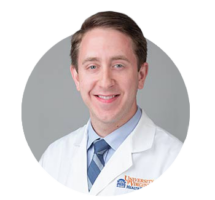 By Anthony Marino, MD
By Anthony Marino, MD
PREVENTIVE, ACUTE, CHRONIC, AND LONGITUDINAL AMBULATORY CARE (PACLAC)
The Preventive, Acute, Chronic, and Longitudinal Ambulatory Care (PACLAC) clerkship is a 6-week rotation in the 3rd year of medical school. PACLAC is a collaboration between the Internal Medicine, Family Medicine, and Geriatrics departments for students to learn about medicine in the outpatient setting. Students work in one clinic during their entire six weeks to immerse themselves in the realm of primary care, learning about the management of chronic conditions and triage and treatment of acute illness, as well as performing in-office procedures. In addition, the students participate in a variety of workshops and seminars that focus on procedural skills, high-yield dermatology conditions, case reports, and humanism in medicine. For anyone interested in serving as a preceptor for PACLAC, please get in touch with Drs. Terri Babineau (Family Medicine) or Anthony Marino (Internal Medicine) to learn more.
Filed Under: Basic Research, Clinical Research, DOM in the News, Education, News and Notes, Research
